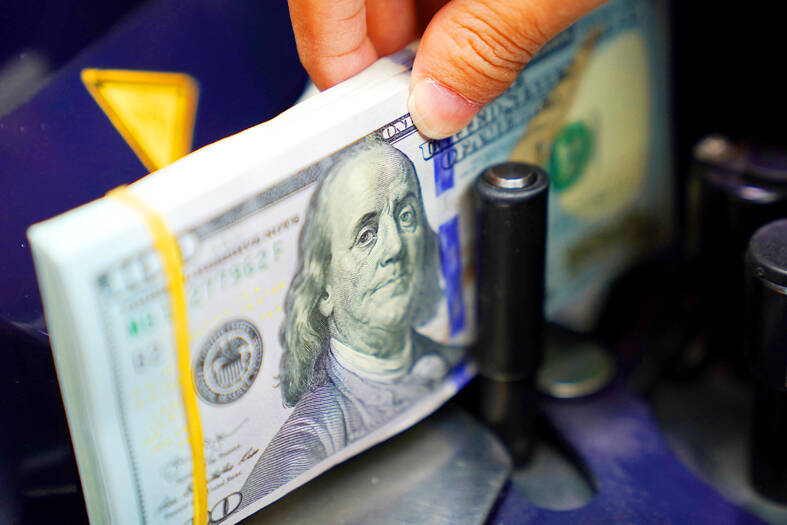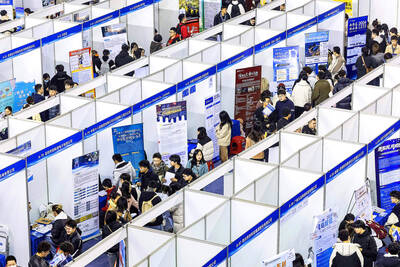The US dollar on Friday dipped as a US Federal Reserve official said rate hikes are likely to slow and investors took profits from earlier gains after last month’s US jobs data and wage inflation were surprisingly robust, obscuring the outlook for how hawkish the US central bank would be.
The greenback initially jumped after data showed that employers added 263,000 jobs last month, well above estimates of 200,000.
“Stronger-than-expected hiring can buy the Fed more time to stay aggressive,” said Joe Manimbo, senior market analyst at Convera in Washington.

Photo: Bloomberg
Investors zeroed in on an increase in average hourly earnings by 0.6 percent in the month, above expectations of a 0.3 percent gain, and the participation rate, which declined to 62.1 percent, said Marc Chandler, chief market strategist at Bannockburn Global Forex in New York.
“Both of those measures reflect more than the nonfarm payroll growth number the tightness of the labor market,” he said.
However, the US dollar gave back gains as investors took profits before the weekend and as Fed officials spoke on the outlook.
Chicago Fed President Charles Evans said that the pace of increases is likely to slow, but the US central bank would likely need to raise borrowing costs to a “slightly higher” peak than envisioned in forecasts from September.
Richmond Fed President Thomas Barkin said the US is likely in a sustained period in which there would continue to be a shortage of workers, complicating the Fed’s aim of getting labor demand back into balance.
The US dollar index on Friday closed down 0.21 percent against a basket of currencies at 104.51, declining 1.37 percent weekly.
The New Taiwan dollar rose against the US dollar on Friday, gaining NT$0.028 to close at NT$30.605, up 0.97 percent from NT$30.905 a week earlier.
The greenback slipped 0.76 percent against the Japanese yen to ¥134.31, while the euro gained 0.15 percent to US$1.0543.
Additional reporting by CNA, with staff writer

Stephen Garrett, a 27-year-old graduate student, always thought he would study in China, but first the country’s restrictive COVID-19 policies made it nearly impossible and now he has other concerns. The cost is one deterrent, but Garrett is more worried about restrictions on academic freedom and the personal risk of being stranded in China. He is not alone. Only about 700 American students are studying at Chinese universities, down from a peak of nearly 25,000 a decade ago, while there are nearly 300,000 Chinese students at US schools. Some young Americans are discouraged from investing their time in China by what they see

Taiwan Transport and Storage Corp (TTS, 台灣通運倉儲) yesterday unveiled its first electric tractor unit — manufactured by Volvo Trucks — in a ceremony in Taipei, and said the unit would soon be used to transport cement produced by Taiwan Cement Corp (TCC, 台灣水泥). Both TTS and TCC belong to TCC International Holdings Ltd (台泥國際集團). With the electric tractor unit, the Taipei-based cement firm would become the first in Taiwan to use electric vehicles to transport construction materials. TTS chairman Koo Kung-yi (辜公怡), Volvo Trucks vice president of sales and marketing Johan Selven, TCC president Roman Cheng (程耀輝) and Taikoo Motors Group

MAJOR DROP: CEO Tim Cook, who is visiting Hanoi, pledged the firm was committed to Vietnam after its smartphone shipments declined 9.6% annually in the first quarter Apple Inc yesterday said it would increase spending on suppliers in Vietnam, a key production hub, as CEO Tim Cook arrived in the country for a two-day visit. The iPhone maker announced the news in a statement on its Web site, but gave no details of how much it would spend or where the money would go. Cook is expected to meet programmers, content creators and students during his visit, online newspaper VnExpress reported. The visit comes as US President Joe Biden’s administration seeks to ramp up Vietnam’s role in the global tech supply chain to reduce the US’ dependence on China. Images on

New apartments in Taiwan’s major cities are getting smaller, while old apartments are increasingly occupied by older people, many of whom live alone, government data showed. The phenomenon has to do with sharpening unaffordable property prices and an aging population, property brokers said. Apartments with one bedroom that are two years old or older have gained a noticeable presence in the nation’s six special municipalities as well as Hsinchu county and city in the past five years, Evertrust Rehouse Co (永慶房產集團) found, citing data from the government’s real-price transaction platform. In Taipei, apartments with one bedroom accounted for 19 percent of deals last